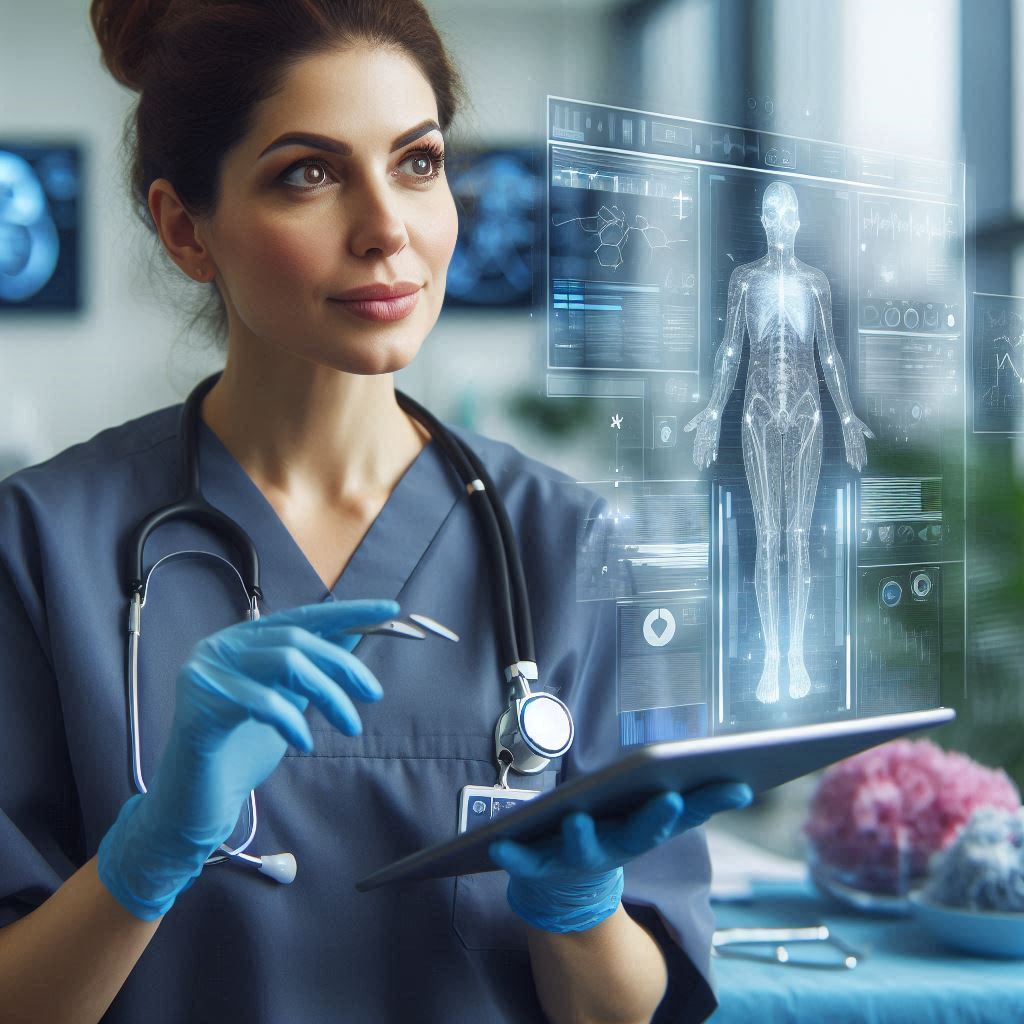Introduction
In recent years, technological advancements have profoundly transformed medical technology.
These innovations not only enhance patient care but also streamline healthcare delivery.
Staying abreast of these advancements is crucial for professionals in the healthcare industry.
Today, technologies like artificial intelligence (AI) and machine learning are revolutionizing diagnostics and treatment planning.
By integrating AI into medical imaging, for example, radiologists can detect subtle abnormalities with greater accuracy and efficiency.
Moreover, wearable devices and remote monitoring systems allow for continuous health tracking, empowering patients and doctors alike.
Precision medicine, another breakthrough, tailors treatment plans based on individual genetic profiles, improving outcomes and reducing adverse effects.
Innovations in surgical robotics have also made procedures less invasive, minimizing recovery times and complications.
The pace of change in medical technology underscores the importance of ongoing education and training.
Healthcare professionals must adapt to these advancements to provide optimal care and remain competitive in their fields.
By embracing technological progress, the healthcare industry not only improves patient outcomes but also fosters a culture of innovation and excellence.
As we look to the future, continued investment in research and development will further propel medical technology forward, shaping a healthier world for generations to come.
Evolution of medical technology
Historical perspective on the development of medical devices and equipment
Medical technology has come a long way since its inception, with advancements revolutionizing the field and improving patient care.
From ancient practices of using herbs and natural remedies to the cutting-edge technologies we have today, the journey of medical technology is fascinating.
In the early days, medical devices were rudimentary and often limited in functionality.
The development of tools like scalpels, forceps, and thermometers laid the foundation for modern medical equipment.
These basic instruments paved the way for more complex devices that we rely on today.
Impact of innovations such as X-rays, MRIs, and robotics in medical procedures
One of the most significant advancements in medical technology was the discovery of X-rays by Wilhelm Roentgen in 1895.
This groundbreaking innovation allowed doctors to see inside the human body without invasive procedures, revolutionizing diagnostics and treatment planning.
The ability to visualize bones, tissues, and organs was a game-changer in medicine.
Transform Your Career Today
Unlock a personalized career strategy that drives real results. Get tailored advice and a roadmap designed just for you.
Start NowAnother key innovation that has transformed medical procedures is the Magnetic Resonance Imaging (MRI) machine.
Developed in the 1970s, this technology uses magnetic fields and radio waves to create detailed images of the body’s internal structures.
MRIs have become essential tools in diagnosing conditions such as tumors, infections, and neurological disorders.
Robotics has also made a significant impact on medical procedures, allowing for precision and efficiency in surgeries.
Robotic surgical systems like the da Vinci Surgical System have revolutionized the way complex procedures are performed, with enhanced accuracy and reduced recovery times.
Surgeons can now perform intricate operations with minimal invasiveness, leading to better patient outcomes.
The integration of technology into healthcare has not only improved patient care but also enhanced research and development in the medical field.
Data analytics, artificial intelligence, and telemedicine are just a few examples of how technology has revolutionized healthcare delivery.
Innovations such as wearable devices and remote monitoring systems have made it easier for patients to manage their health and stay connected to healthcare providers.
As medical technology continues to evolve, the possibilities for innovation are endless.
From personalized medicine to 3D printing of organs, the future of healthcare holds exciting prospects.
With a focus on improving patient outcomes and enhancing quality of care, advancements in medical technology will continue to shape the future of medicine.
Read: Top Schools for Mental Health Counseling Degrees
Improved diagnosis and treatment
Technological advances in medical technology have revolutionized the way healthcare professionals diagnose and treat patients.
One area that has seen significant improvements is in the diagnosis and treatment of various medical conditions.
How advancements in imaging technology have enhanced diagnostic accuracy
Advancements in imaging technology have played a crucial role in enhancing diagnostic accuracy.
Gone are the days of relying solely on basic X-rays or invasive procedures to identify diseases.
Now, medical professionals have access to a wide range of imaging modalities, such as MRI, CT scans, and ultrasound, that provide detailed images of internal structures.
These imaging technologies allow physicians to detect abnormalities at an earlier stage, leading to quicker interventions and better outcomes for patients.
Additionally, the high-resolution images produced by these modalities enable healthcare providers to make more precise diagnoses, resulting in more targeted treatment plans.
Transform Your Career Today
Unlock a personalized career strategy that drives real results. Get tailored advice and a roadmap designed just for you.
Start NowBenefits of Precision Medicine
Another significant advancement in medical technology is the rise of precision medicine.
This approach takes into account individual variability in genes, environment, and lifestyle to tailor treatment plans to the specific needs of each patient.
By analyzing a patient’s genetic makeup, doctors can determine the most effective medications and therapies for their condition, minimizing the risk of adverse reactions and improving overall treatment outcomes.
This personalized approach to healthcare has the potential to revolutionize the field of medicine, offering patients more effective and efficient care.
In addition to improving treatment outcomes, precision medicine can also help reduce healthcare costs by avoiding unnecessary treatments and procedures that may not benefit the patient.
This targeted approach ensures that resources are allocated more efficiently, leading to better overall healthcare outcomes for both patients and healthcare systems.
In fact, technological advances in medical technology, particularly in imaging and precision medicine, have greatly improved the diagnosis and treatment of medical conditions.
These innovations have paved the way for more accurate diagnoses, personalized treatment plans, and better outcomes for patients.
As technology continues to evolve, the future of medicine looks promising, with even more groundbreaking advancements on the horizon.
Read: Understanding the Role of a Telehealth Specialist
Telemedicine and remote monitoring
Telemedicine and remote monitoring have revolutionized the healthcare industry, providing increased access to medical services and enhancing patient care.
Expanded Access to Healthcare Services
Telemedicine allows patients to consult with healthcare providers remotely, breaking down barriers such as distance and transportation.
This means that individuals in rural or underserved areas can receive medical attention without having to travel long distances to see a doctor.
Furthermore, telemedicine has made it easier for individuals with mobility issues or chronic conditions to access healthcare services.
Through virtual appointments, patients can receive timely medical advice and prescriptions without leaving their homes.
Additionally, telemedicine has been instrumental during emergencies or natural disasters when traditional healthcare facilities may be inaccessible.
Patients can connect with healthcare professionals through telemedicine platforms, ensuring continuity of care even in challenging circumstances.
Overall, telemedicine has democratized healthcare by making medical services more accessible and convenient for a broader range of individuals, ultimately improving health outcomes and reducing healthcare disparities.
Importance of Remote Monitoring Devices
Remote monitoring devices play a crucial role in managing chronic conditions and preventing hospital readmissions.
These devices allow healthcare providers to track patients’ vital signs and health metrics in real-time, enabling early intervention and personalized care.
Transform Your Career Today
Unlock a personalized career strategy that drives real results. Get tailored advice and a roadmap designed just for you.
Start NowFor patients with chronic conditions such as diabetes, heart disease, or hypertension, remote monitoring devices provide continuous monitoring outside of clinical settings.
This constant stream of data helps healthcare professionals adjust treatment plans, identify trends, and prevent potential complications before they escalate.
Remote monitoring also enhances patient engagement and self-management by empowering individuals to take an active role in monitoring their health.
Patients can track their progress, set goals, and share data with their healthcare team, fostering a collaborative approach to care.
Moreover, remote monitoring devices have been shown to reduce hospital readmissions by alerting healthcare providers to any concerning changes in patients’ health status.
This proactive approach can prevent avoidable hospital stays and improve overall patient outcomes.
In short, remote monitoring devices are valuable tools in modern healthcare, offering a proactive and patient-centered approach to managing chronic conditions and reducing the burden on traditional healthcare systems.
Read: Work Environments for Medical Technologists

Artificial Intelligence and Machine Learning
Artificial Intelligence (AI) and Machine Learning (ML) have revolutionized the field of medical technology.
These advanced technologies play a crucial role in analyzing medical data and predicting outcomes with high accuracy and efficiency.
AI algorithms are designed to learn from the data they process, enabling them to identify patterns and make predictions based on complex datasets.
Role of AI in Analyzing Medical Data and Predicting Outcomes
AI-driven analysis of medical data allows healthcare professionals to make more informed decisions regarding patient care and treatment plans.
AI can analyze vast amounts of data in a fraction of the time it would take a human, leading to faster and more accurate diagnoses.
By predicting outcomes based on historical data, AI can help healthcare providers customize treatment plans for individual patients.
AI-powered predictive analytics can identify high-risk patients, allowing for early intervention and prevention of complications.
Examples of AI-Powered Tools Used in Medical Imaging, Drug Discovery, and Patient Care
- Medical Imaging: AI algorithms are used to analyze medical images, such as X-rays and MRIs, to detect abnormalities and assist radiologists in making accurate diagnoses.
- Drug Discovery: AI is utilized in drug discovery processes to identify potential drug candidates, predict their efficacy, and streamline the drug development pipeline.
- Patient Care: AI-powered chatbots and virtual assistants help patients access information, schedule appointments, and receive personalized healthcare recommendations.
In general, Artificial Intelligence and Machine Learning have significantly enhanced the capabilities of medical technology.
These technologies continue to drive innovation in healthcare, improving patient outcomes and transforming the way medical professionals diagnose and treat various conditions.
Read: Preparing for Certification Exams as a Surgical Technologist
Robotics in Surgery
Robotic-assisted surgeries have revolutionized the field of medicine, offering numerous advantages over traditional surgical procedures.
Advantages of Robotic-Assisted Surgeries
- Precision: Robots can perform intricate tasks with unparalleled accuracy, reducing the risk of human error.
- Efficiency: Robotic systems can complete procedures more quickly and efficiently, leading to shorter surgery times.
- Recovery Time: Patients undergoing robotic-assisted surgeries often experience faster recovery times and less post-operative pain.
Challenges and Future Opportunities
While robotics in surgery offer significant benefits, there are also challenges that need to be addressed for widespread adoption.
Transform Your Career Today
Unlock a personalized career strategy that drives real results. Get tailored advice and a roadmap designed just for you.
Start Now- Cost: The initial investment in robotic systems can be high, making it inaccessible for some medical facilities.
- Training: Surgeons need specialized training to operate robotic systems effectively, which can be time-consuming.
- Lack of tactile feedback: Robotic systems lack the sensory feedback that human touch provides, which can impact surgical precision.
Despite these challenges, the future of robotics in surgery looks promising, with several opportunities for incorporation into everyday medical practices.
- Enhanced capabilities: As robotic technology advances, we can expect robots to perform increasingly complex surgical procedures with precision.
- Telemedicine: Robotics can enable remote surgeries, allowing expert surgeons to operate on patients in distant locations.
- Patient outcomes: By improving surgical precision and reducing recovery times, robotics can lead to better patient outcomes and satisfaction.
In a nutshell, robotics in surgery offer numerous advantages in terms of precision, efficiency, and recovery time.
While there are challenges to overcome, the future of incorporating robotics into everyday medical practices looks promising.
Explore Further: Daily Routine of a Speech-Language Pathologist
Gain More Insights: Recreational Therapy for Eating Disorders
Conclusion
Technological advances in medical technology have revolutionized patient care and outcomes.
Innovations like AI and robotics streamline diagnostics and surgeries. These advancements enhance precision and reduce recovery times.
Remote monitoring and telemedicine connect patients with specialists globally. Patient data analytics improve treatment strategies and personalized care plans.
Wearable devices empower patients to manage chronic conditions proactively.
The impact is profound, promoting better health management and early intervention. Healthcare professionals must embrace these tools to enhance efficiency.
Embracing innovation ensures staying at the forefront of patient care. The future promises even more transformative advancements.
Let’s commit to leveraging technology for better healthcare.




